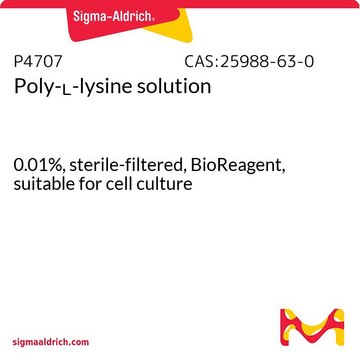추천 제품
Product Name
Poly-D-lysine hydrobromide, mol wt >300,000, lyophilized powder, γ-irradiated, BioReagent, suitable for cell culture
생물학적 소스
synthetic (chemical)
Quality Level
무균
γ-irradiated
제품 라인
BioReagent
BioXtra
양식
lyophilized powder
분자량
>300,000
포장
pkg of 5 mg
농도
0.016—0.032 mmol lysine
기술
cell culture | mammalian: suitable
표면 범위
4 μg/cm2
solubility
H2O: soluble 50 mg/mL, clear, colorless
배송 상태
ambient
저장 온도
−20°C
SMILES string
O=C(C)[C@@](NC)([H])CCCCN.[Br]
InChI
1S/C6H14N2O2.BrH/c7-4-2-1-3-5(8)6(9)10;/h5H,1-4,7-8H2,(H,9,10);1H
InChI key
MEXAGTSTSPYCEP-UHFFFAOYSA-N
유사한 제품을 찾으십니까? 방문 제품 비교 안내
일반 설명
Poly-D-Lysine Hydrobromide (PDL) is a cationic polymer composed of lysine residues with an associated hydrobromide molecule per lysine unit. The presence of the hydrobromide molecule introduces a distinctive property to the poly-D-lysine structure allowing the poly-D-lysine to adopt a crystalline form, rendering it soluble in aqueous solutions.
애플리케이션
Poly-D-lysine hydrobromide has been used :
- in preparing the surface of coverslips for cell attachment
- in coating glass-bottom dishes for live cell imaging of primary cortical neuronal cells
- in coating 24-well plates for the isolation of primary astrocytes to study the impact of melanoma-derived exosomes on the reprogramming of stromal cells within the metastatic microenvironment
- for coating 16-well chamber slides to study the effects of maternal immune activation on behavioral impairments and alterations in cytokine and synaptic protein expression in the cerebellum
Poly-D-lysine polymers can be used in preparing surfaces for cell attachment. The D-lysine polymers can also be used with cells that digest poly-L-lysine polymers and cause an excessive uptake of L-lysine.
This product is recommended as a cell culture substratum when using 0.5 - 1.0 mL of a 0.1 mg/mL solution to coat 25 cm2. Lower molecular weight versions of the product are less viscous, but high more molecular weight versions provide more attachment sites per molecule.
This product is recommended as a cell culture substratum when using 0.5 - 1.0 mL of a 0.1 mg/mL solution to coat 25 cm2. Lower molecular weight versions of the product are less viscous, but high more molecular weight versions provide more attachment sites per molecule.
생화학적/생리학적 작용
Poly-D-Lysine Hydrobromide (PDL) is a nonspecific attachment factor for cells useful in promoting cell adhesion to solid substrates by enhancing electrostatic interaction between negatively charged ions of the cell membrane and the culture surface. PDL increases the number of positively charged cell binding sites post-absorption to the culture surface. PDL coating promotes the attachment of cells to solid surfaces that usually grow in suspension.
Poly-D-lysine (PDL) hydrobromide is a nonspecific attachment factor for cells useful in promoting cell adhesion to solid substrates by enhancing electrostatic interaction between negatively charged ions of the cell membrane and the culture surface. After absorption to the culture surface, poly-D-lysine increases the number of positively charged cell binding sites.
성분
Poly-D-lysine is a positively charged amino acid polymer with approximately one HBr per lysine residue. The hydrobromide allows the poly-D-lysine to be in a crystalline form soluble in water. A small amount of product may be found in the ß structure because the HBr interferes with hydrogen bonding between amino and either the carboxyl groups or N or O containing moieties.
주의사항
Sterile solutions are stable for up to 2 years when stored at 2-8°C. It should be stored desiccated at -20°C.
분석 메모
This product has a molecular weight >300,000 and is cell culture tested and gamma-irradiated. To remove the HBr, dissolve this product in a neutral buffer and dialyze to remove the salts. In general, to use this product as an attachment factor, add 50 mL of sterile tissue culture grade water to 5 mg of poly-lysine, and aseptically coat the surface with 1 mL per 25 cm2 of solution. After 5 minutes, remove the solution through aspiration and thoroughly rinse the surface. Let dry for two hours before introducing cells and medium.
Storage Class Code
11 - Combustible Solids
WGK
WGK 3
Flash Point (°F)
Not applicable
Flash Point (°C)
Not applicable
개인 보호 장비
Eyeshields, Gloves, type N95 (US)
이미 열람한 고객
자사의 과학자팀은 생명 과학, 재료 과학, 화학 합성, 크로마토그래피, 분석 및 기타 많은 영역을 포함한 모든 과학 분야에 경험이 있습니다..
고객지원팀으로 연락바랍니다.




